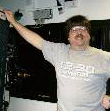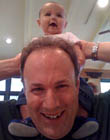|
|
 
|
|
Author
|
Topic: 16mm production
|
Jerry Chase
Phenomenal Film Handler

Posts: 1068
From: Margate, FL, USA
Registered: Nov 2000
|
 posted 04-07-2001 11:08 AM
posted 04-07-2001 11:08 AM




I was asked by a friend, "If I wanted to do a short (20 minute) film on 16mm, with the possibility of eventually blowing it up to 35mm, what would be the least expensive or most practical way to do this?"I don't think he realizes the costs involved, and I think he will probably back out quickly when he realizes the work and planning required, but I'd like to answer his question anyway, but I have no clue. Anyone got ideas? Any magazines he should subscribe to, or and books he should get? Taking a full college program on the subject is way beyond his means or interest, except for doing this one short. What would costs include? What do lab costs run? Recommended equipment? Recommended film stock? Is rental still the way to go, or are prices low enough that passable equipment can be purchased used? What is used for sound on 16mm now? Any possibility of synch to digital sound? Now that I'm asking, I'm curious myself what a guerilla film-maker can get by with.
| IP: Logged
|
|
Darryl Spicer
Film God

Posts: 3250
From: Lexington, KY, USA
Registered: Dec 2000
|
 posted 04-07-2001 11:35 AM
posted 04-07-2001 11:35 AM



one thing to remember the big cost will probably be film stock and developing and sound developing. Yes your sound is recorded on a seperate tape machine and then is transfered to a sound stock used for editing. Once editing has been done the two are processed at a lab and everything is synced together. Unless you are able to make things a perfect shoot. You will probably be using three times the amount of film stock that you want to use. Costs can sky rocket quickly.I was going to take part in a production two years ago, but things fell thru when the guy could no longer raise the money needed for this production. So it never got off the ground. Importantly too is that if the stock is miss handled during the switchover process of moving stock from magazine to storage can. Your whole days shooting can be ruined in an instant. This switch over is done blind using a small darkroom tent that you stick your hands in. If this person is serious about what he wants to do. Then what I would do is find the best quality video cameras and shoot the production with them. If it is good enogh he may be able to use that to get backing and other support to do another production using film. Sorry I can't provide any numbers for costs. These numbers were handled by someone else.
| IP: Logged
|
|
|
|
|
|
Scott Norwood
Film God

Posts: 8146
From: Boston, MA. USA (1774.21 miles northeast of Dallas)
Registered: Jun 99
|
 posted 04-07-2001 12:24 PM
posted 04-07-2001 12:24 PM





If he really wants a 35mm print as the final product, it might be cheaper just to shoot 35mm from the start if the shooting ratio isn't too high. Quality blowups aren't cheap; they can look stunning if the 16mm original is well photographed, but if the cost difference isn't too much anyway, 35mm origination would be the way to go.
Kodak has a catalog of 16mm and 35mm camera films that they will send you; cost is generally around $.33-35/foot for color negative film. This needs to be processed at a film lab and workprinted for editing (this varies by lab, but figure on $.14/foot for negative processing and $.20/foot for workprinting). Also, figure on about $.07/foot to transfer sound from 1/4" Nagra or DAT tape to 16mm mag film. After editing, the sound will probably have to be mixed (not cheap; figure $150/hour of studio time in NYC or LA) and the negative will have to be cut (DIY and risk trashing the negs or pay about $4/cut to have someone else do it). Optical track negatives cost $.20-.30/foot. Answer prints (the first print you make) cost $.75-1.50/foot (shop around for prices here...they're all over the map). After that, 16mm release prints general go for $.25-35/foot, depending on quantity.
As for equipment, the cheapest sync cameras that you would want to use generally rent for about $100/day, plus figure another $100/day for lenses, mags, tripod, etc. Nagra or DAT recorders rent for $50/day or so and then figure on maybe another $50/day for microphones, cables, etc. Outside of major cities, these prices may be higher or lower, or the equipment may be unavailable. Lighting equipment prices vary all over the place. Editing equipment (Steenbecks and Moviolas) can often be found available for free use with a few phone calls. It's also possible to edit electronically (either on videotape or computer) and conform the film neg to a cut list, but this usually ends up costing much more, and doesn't really obviate the need for workprints to check for focus and exposure on a largeish screen.
Bottom line: it isn't cheap. But transferring video to film costs even more and the quality is substantially worse.
| IP: Logged
|
|
|
|
|
|
|
|
|
|
|
|
|
|
|
|
All times are Central (GMT -6:00)
|
|
Powered by Infopop Corporation
UBB.classicTM
6.3.1.2
The Film-Tech Forums are designed for various members related to the cinema industry to express their opinions, viewpoints and testimonials on various products, services and events based upon speculation, personal knowledge and factual information through use, therefore all views represented here allow no liability upon the publishers of this web site and the owners of said views assume no liability for any ill will resulting from these postings. The posts made here are for educational as well as entertainment purposes and as such anyone viewing this portion of the website must accept these views as statements of the author of that opinion
and agrees to release the authors from any and all liability.
|

 Home
Home
 Products
Products
 Store
Store
 Forum
Forum
 Warehouse
Warehouse
 Contact Us
Contact Us




 Printer-friendly view of this topic
Printer-friendly view of this topic
















